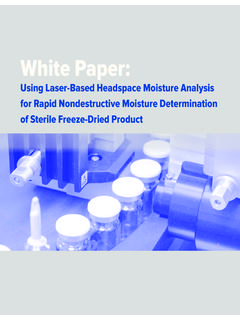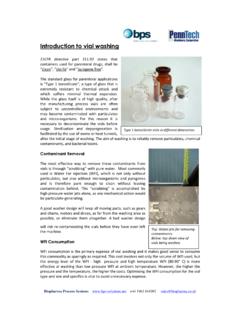Transcription of Why, What and How? Understanding the freeze …
1 The advantages of freeze drying freeze drying , also known as lyophilisation is a method of processing a liquid product into a dry solid product. With freeze - drying , heat-sensitive drugs and biologicals can be dried at low temperatures. The avoidance of high temperatures helps to reduce the extent of decomposition or loss of activity in biological products, and can also circumvent the alteration of taste and sensory qualities in foods. freeze -dried products have a very high surface area, which enables them to be reconstituted quickly and easily with the re-introduction of the solvent (usually water).
2 This is particularly valuable in the case of emergency vaccines and antibodies, which need to be solubilised and administered as quickly as possible. Foods (see figure 1) benefit from being freeze dried as their sensory qualities such as colour, size, smell and taste are only minimally affected in comparison to other drying processes. freeze drying is also more compatible with the production of particle-low pharmaceuticals, in comparison to dry powder filling. Solutions can be sterile filtered immediately before being transferred to vials and freeze -dried.
3 freeze drying can increase a product s viable storage time at more economical and practical temperatures. freeze drying a vaccine, for example, can increase product lifetime from just a few hours/days to several months/years, which has clear advantages; reducing the importance and criticality of forecasting product demand, storage facility requirements, transport logistics and associated costs of these. In short, freeze - drying offers a range of advantages to alternative methods. The freeze drying process freeze drying involves removing the water from a material, a process which involves three stages.
4 First, the product is frozen to a defined temperature, then the free ice is removed during primary drying by sublimation under vacuum. Finally, in secondary drying , typically at a higher temperature and lower pressure, much of the remaining (unfrozen) water may be desorbed under vacuum. A typical freeze -dried product will occupy the same volume as the original sample, even if it was initially a liquid. This "cake" as it is usually known may be fragile and should be easy to reconstitute. Many freeze -dried products are therefore hygroscopic and for preservation need to be kept in a closed container.
5 freeze - drying in the pharmaceutical and biotech industries is commonly carried out in vials (figure 2) but it may be carried out in a number of other formats, for example ampoules, trays (known as bulk drying ). In laboratories, material is sometimes freeze dried in flasks, attached to small-scale manifold dryers. Newer innovations in the field include drying in blister packs and syringes. Critical temperatures for freeze drying For successful and robust lyophilisation, the behaviour of the frozen product needs to be characterised prior to freeze drying . Parameters such as collapse temperature (Tc), glass transition in the frozen state (Tg ), eutectic temperature (Teu), molecular mobility, knowledge of excipient and active characteristics ( an amorphous or crystalline material) need to be understood for the development of a rational and economical freeze drying cycle.
6 The resulting end product should have an accept-able cake structure (see figure 5), good rehydration time, and retention of active viability with sufficient stability at the required temperature; the exact requirements will vary with the end product and market. The collapse temperature (Tc) can be defined as the point at which an amorphous material in the frozen state when subjected to a vacuum can no longer maintain its Why, what and How? Understanding the freeze drying process I. Cook, Principal Scientist, Biopharma Technology Ltd Figure 1: Examples of freeze -dried foods Figure 2: freeze drying in vials A complex material can provide many challenges and often additional information on the frozen product is required.
7 This can be provided by analysis of both the thermal events and impedance changes within the frozen product; this can be conducted with the Lyotherm2 instrument using about 6ml of material. Exothermic or endothermic changes can be observed as a solution freezes, melts or softens using differential thermal analysis (DTA). Impedance (ZSin ) analysis can detect possible structural changes/molecular mobility which can contribute significant information on sample behaviour (see figure 4). Once a product has been analysed and critical points determined, an assessment can be made as to whether the formulation is suitable for freeze drying and additionally what processing options are important for efficient and economical freeze drying .
8 Why shorten your freeze drying cycle? Generally freeze drying production equipment does not go lower than -70 C and this in itself provides a limita-tion on how low a temperature a prod-uct can be commercially freeze dried. Another important factor is the time, energy and consequently cost. A product with a low freeze drying tem- structure as the frozen solvent is removed during dry-ing. A collapsed product often has a poor re-hydration time, low retention of active viability and high residual water level, as well as a shrunken, cosmetically unac-ceptable appearance (see figure 5). The glass transition temperature in the frozen state (Tg ) is the point at which an amorphous material shows signs of softening indicating a possible loss of structure may occur.
9 Tc and Tg values can be quite close, though Tg is generally lower than the equivalent Tc. A 1 C increase in shelf temperature during primary drying can lead to a 13% decrease in drying time; therefore measurement of the Tc can lead to a significant saving of both time and money, whilst still retaining a good end product. The eutectic temperature (Teu) is the point at or above which a frozen eutectic solid becomes a liquid which would boil as the solvent is removed. Tc and Teu can be measured by freeze drying microscopy (FDM). Here at Biopharma Technology Ltd (BTL) we use our purpose-designed Lyostat2 instrument.
10 This is essentially a micro- freeze dryer and enables analysis of a formulation with only 2 l of material. The material is placed on the cryo-stage under a microscope, the sample is held between two slides with a spacer in between to control the thickness of material. The sample is freeze dried under controlled conditions and its behaviour observed at different temperatures. Most products are at least partially amorphous and need to be dried below their collapse point; therefore, measurement of this is important for defining the maximum allowable product temperature during primary drying .





